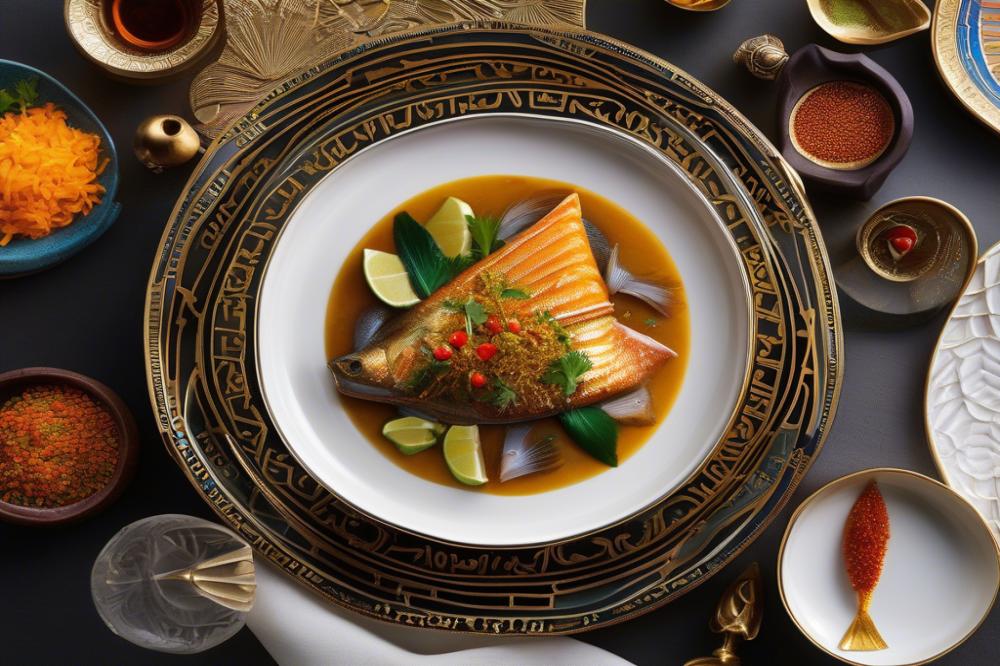Exploring the Flavors of Egyptian Feseekh fermented fish
Feseekh, a traditional dish in Egyptian cuisine, has been enjoyed for centuries. This fermented fish shines a spotlight on unique culinary practices that have been passed down through generations. Made primarily from Nile fish, it represents a unique approach to food preservation that highlights a distinct flavor profile.
The preparation of salted fish involves a meticulous process filled with cultural significance. Families often gather to create this dish, embracing tradition and community. Fermentation transforms the fish over time into something that is both savory and pungent, provoking a range of reactions among the adventurous eaters.
In Egypt, Feseekh often takes center stage during major celebrations and festivals. Its presence at feasts highlights a connection to heritage that many hold dear. Citizens associate the dish with special occasions, bringing people together to share in its bold tastes and stories from the past.
When it comes to Egyptian flavors, few can compare to the distinctive profile of this fermented delight. The health benefits of fish fermentation also resonate with those who seek to understand traditional ways of food handling. Enjoying Feseekh brings a deeper appreciation of the culture behind this beloved dish.
Understanding Feseekh

Feseekh is a traditional dish in Egyptian cuisine, made from fermented fish. The process involves leaving Nile fish, typically mullet, to ferment in a mixture of salt for several days or even weeks. This age-old technique not only enhances the flavors but also helps to preserve the fish for a longer duration. Salted fish offers a distinct taste that can be an acquired one for many. After fermentation, the fish develops a strong aroma and a tangy flavor.
Nile fish are chosen specifically due to their availability and cultural importance. These fish thrive in the rich waters of the Nile River, making them a staple in the Egyptian diet. The fermentation process is a testament to the ingenuity of ancient societies, as they needed methods to keep food edible during times of scarcity. Salted fish became not just a source of nourishment but also a part of daily life, particularly during significant events.
Food preservation methods like this were vital in ancient Egyptian society. They allowed communities to store fish, minimizing waste and ensuring sustenance throughout the year. This practice also reflects the cultural significance of the Nile River, which has been central to life in Egypt for millennia. Over time, the techniques surrounding fish fermentation evolved, but the essence of the dish remained intact.
Feseekh holds a celebrated place in Egyptian culinary heritage. It is often prepared during religious festivals and special occasions, showcasing the diversity of Egyptian flavors. Its role goes beyond mere sustenance; this dish serves as a symbol of tradition and unity during festive gatherings. For many Egyptians, enjoying feseekh with family and friends is an experience that connects them to their roots and shared history.
Ingredients and Cooking Instructions

To prepare this traditional dish, gathering the right ingredients is key. You will need:
- Nile tilapia or mullet (1 kg)
- Coarse sea salt (200 g)
- Clean water (1 liter)
For added flavor, there are optional spices you can consider:
- Coriander (1 tsp)
- Cumin (1 tsp)
- Garlic (2 cloves, minced)
Method
Begin by cleaning and gutting the fish thoroughly. This step is essential for food preservation and safety. Next, prepare a saltwater brine. Combine the coarse sea salt with clean water to create the brine solution.
Submerge the fish in this brine. Make sure to cover it with a weight or another object to keep it underwater. This process should last for 24 to 48 hours. It helps in the fermentation of the fish, capturing those deep Egyptian flavors.
After brining, remove the fish and allow it to dry. Place it in the sun for about 2 to 3 days. The goal is to achieve a hard skin, which indicates that the drying process is complete. Proper drying is crucial in many recipes and especially in traditional salted fish preparation.
Once dried, store the fish in a cool, dry place, or consider placing it in jars for further fermentation if you desire a more robust flavor. This method highlights the culinary heritage and cultural significance of Egyptian festivals related to fermented fish.
Nutritional Information
The fish you choose, such as Nile tilapia or mullet, offers numerous health benefits. It is rich in protein, omega-3 fatty acids, and essential vitamins like B12 and D. Sea salt, while providing important minerals, should be consumed judiciously.
Adding optional spices can enhance the overall experience. Garlic, for instance, offers antioxidants, while cumin is known for its anti-inflammatory properties. These flavors and health benefits combine to create a truly exciting dish reflective of Egypt’s rich culinary landscape.
Culinary Usage and Serving Suggestions

During Egyptian festivals, particularly Sham El-Nessim, the traditional dish made from fermented fish takes center stage. Celebrated each spring, this festival welcomes the changing seasons and highlights cultural significance. Families gather to enjoy an array of foods, but this salted fish stands out for its bold flavors and rich history.
A typical serving plate often includes warm, freshly baked bread. This staple acts as a perfect companion, helping to balance the strong taste of the fish. Pickled vegetables add another layer; their tangy crunch complements the saltiness. Various salads, often filled with greens and herbs, also play an important role. These refreshing side dishes provide a contrast, enhancing the overall dining experience.
Modern interpretations of this dish reflect changes in culinary preferences. Some chefs experiment by incorporating different spices or serving the fish alongside traditional grains. This adaptation showcases a blend of Egyptian flavors while honoring culinary heritage. The growing trend of food preservation, including fish fermentation, highlights how ancient techniques still resonate today. Now, even non-traditional formats are gaining popularity, such as Feseekh tacos or wraps.
Exploring the diversity in serving options can open new conversations about Nile fish. This dish encourages creativity in preparation, blending the old with the new while remaining true to cultural roots. As Egyptians embrace both heritage and innovation, the potential for this fermented fish continues to expand.
Cultural Significance of Feseekh

Feseekh plays a vital role in Egyptian festivals, especially during Sham El-Nessim. This traditional dish is not just a meal; it carries deep symbolic meaning in society. Every spring, families gather to celebrate, honoring their rich culinary heritage. Feseekh, made from fermented fish, showcases ancient techniques of food preservation that date back thousands of years.
During Sham El-Nessim, people indulge in salted fish as part of a larger celebration. This gathering encourages connections among friends and family. People often share meals, laugh, and enjoy each other’s company. As they sit together, they reflect on traditions passed down through generations. Each bite of feseekh is a taste of history, linking them to their roots.
Rituals surrounding its preparation are equally important. Many families have their own unique methods of fish fermentation, often handed down through the years. Catching Nile fish adds a special touch to the process. Families might come together to fillet and cure the fish, making it a fun, collaborative effort. Children often participate, learning the skills and customs of their elders.
Sharing feseekh extends beyond personal ties. The dish serves as a bridge among communities, fostering a sense of belonging. Neighborhoods often engage in celebrations, creating a joyful atmosphere during festivals. Conversations flow easily as people gather around, united by a shared love for this iconic dish.
In summary, feseekh embodies much more than food. It represents a tapestry of connections, both familial and communal. The act of preparing and eating it nurtures relationships and strengthens cultural bonds. Each celebration becomes a moment to cherish, filled with laughter, flavors, and memories.
Final Thoughts on a Culinary Symbol
Egyptian fermented fish serves as a remarkable representation of the country’s rich flavors and culinary heritage. As one delves into the world of this traditional dish, it becomes clear that it is more than just food. It reflects the time-honored practices of a culture that values its history and traditions.
Each bite of this unique delicacy carries with it stories of generations. Families gather to enjoy this dish, linking past and present through shared culinary experiences. Such traditions play a crucial role in maintaining a community’s identity. The significance of this meal extends beyond mere sustenance; it is a cultural experience that fosters connections.
In modern Egyptian culture, understanding and appreciating this dish enhances our grasp of the local food scene. Acknowledging how it fits into daily life helps preserve these age-old customs. As preferences shift and new tastes emerge, the essence of traditional flavors remains essential. Engaging with dishes like this allows for a deeper appreciation of what it means to be connected to one’s roots.
In summary, the journey through the flavors of this dish offers insights into Egyptian life. Experiencing this savory delight opens a door to cultural understanding. Therefore, supporting and sustaining such practices is vital in keeping the spirit of these culinary traditions alive.



